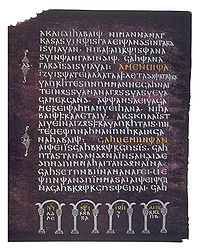
Photo from wikipedia
The aim of this article is to investigate the history of the Cyrillic manuscript transcription of Selenographia (1647), which details Moon observation – the work of Polish–Lithuanian Commonwealth astronomer Johannes… Click to show full abstract
The aim of this article is to investigate the history of the Cyrillic manuscript transcription of Selenographia (1647), which details Moon observation – the work of Polish–Lithuanian Commonwealth astronomer Johannes Hevelius (Jan Heweliusz, 1611–1687). The codex is relevant in two aspects: first, as an example of a late-17th century book, incorporating the characteristics of both a manuscript and a printed publication; and second – as an example of scientific literature in the Commonwealth. Hevelius is a well-known sciencist. The researcher is recognized as the first precise topographer of the Moon. He has composed a catalogue of 1564 stars, discovered four comets, and defined new boundaries of several constellations. In historiography, the manuscript translation of Selenographia has been known since the end of the 19th century. However, in the beginning of the 20th century, the transcript was equated to a piece owned by Tsar Feodor III Alexeyevich (1661–1682), which was present in his library in 1682. The manuscript has been studied by multiple linguists, astronomers, and museologists from various countries; however, it is still yet to receive attention from Lithuanian scientists. This article aims to clarify the currently available scientific information regarding the manuscript version of J. Hevelius’s work Selenographia, which is presently kept in the Manuscript Department of the Wroblewski Library of the Lithuanian Academy of Sciences (LMAVB). This study also seeks to answer the following questions: whether the scientists of the GDL were aware of the piece and its Slavic translation, if there is a possibility that the codex may have belonged to the library of Tsar Feodor III Alexeyevich, and what are the history and the lifecycle of the codex. The object of this investigation is a manuscript codex (LMAVB RS F19–318) archived in the LMAVB. A digital copy of an exemplar archived in the Zurich ETH Library was used for comparative analysis. The history of astronomy in 17th century Europe and the GDL, as well as the placement of this work of Hevelius in that history, is shortly discussed and based on a literary analysis. This information was used to evaluate the scientific value of the manuscript codex under investigation and make conclusions regarding any possible demand for the translations of Selenographia in the GDL’s scientific environment of that time. Codicological and comparative analyses with the original print enabled to consider the circumstances of the translation and transcription of Selenographia and establish the characteristics of the manuscript codex. It was determined that the text is written in a hybrid Church Slavic language; it is written by several scribes in the Calligraphic Book Font with characteristics of the Chancellerie Font, distinctive to the cursives used in the 17th century in Kiev and Moscow. The transcription of the translation is illustrated with original copper engravings (17 of 140), hand-drawn copies of original drawings (17), and original (3) pictures. The majority of illustrations are missing, some blank gaps meant for tables are present, and several tables have been redacted completely. The contents of Selenographia were adapted to fit the environment of its purchaser: all dedications and celebratory texts dedicated to Hevelius were removed and supplementary texts were eliminated, an original preface created by the translator was added, and only an anonymous “ruler” is mentioned. The transcription of the text was intended to maintain the order of the text and illustrations as well as the exact glosses system present in the margins. All numbers and dates have been written in the Cyrillic alphabet; however a Western year numbering system was maintained, and the surnames of scientists were retained in their original Latin forms; objects named in schemes and diagrams were presented in the Latin alphabet. The coinciding fragments of an extant Selenographia translation (chapters 48, 51, 54, and 55) and texts of the codex kept in the LMAVB archives allow us to conclude that it is a translation made by S. Chizhinski during his service in Posol’skii prikaz (Moscow) in 1678–1681. Based on all the defined characteristics, as well as the unfinished appearance of the book and the variety of paper used, it may be concluded that it is a transcription meant for the diplomatic needs of Posol’skii prikaz rather than for the personal library of the Tsar.Efforts to find any evidence of the discussed Selenographia translation in the history of astronomy and book history in Lithuania were unsuccessful. It was not possible to clarify the history of the function of the codex as well. Nonetheless, the history of this book focuses one’s attention to another little-studied topic in Lithuania – the connections of literature and book culture in the 17th century that bridge the GDL and the Tsardom of Russia. To sum up, it may be concluded that access to new archival sources in Russia and Lithuania and a detailed chemical analysis of materials making up the codex (the ink in particular) would affirm or deny the conclusions reached in this study.
Journal Title: Knygotyra
Year Published: 2019
Link to full text (if available)
Share on Social Media: Sign Up to like & get
recommendations!